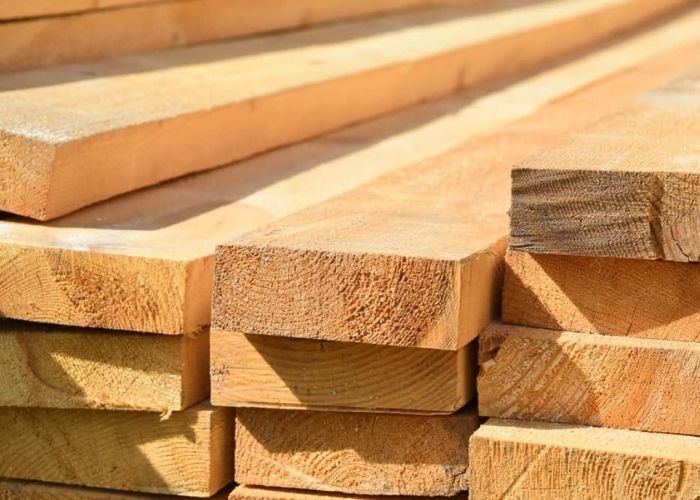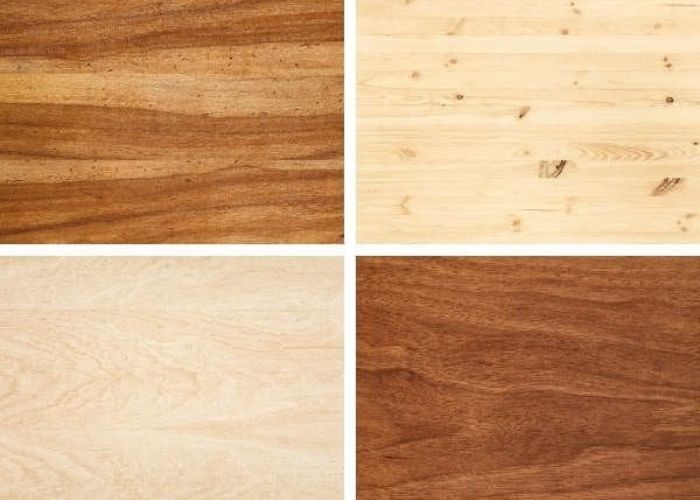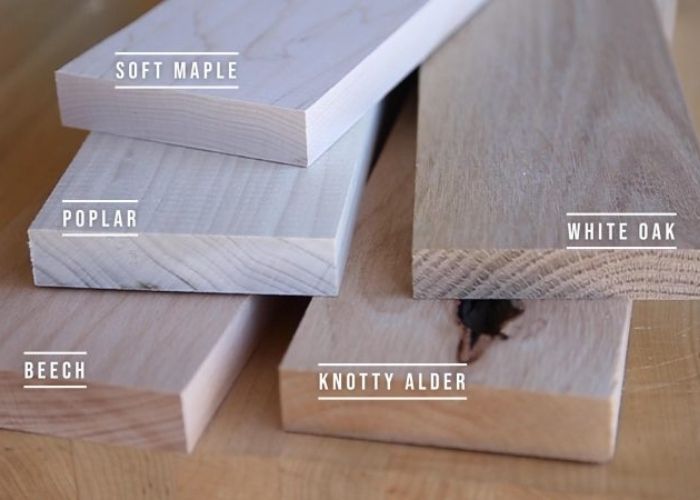Hardwoods are the gold standard for furniture makers, cabinetmakers, and other woodworkers. Hard, stable, and available in various beautiful natural colors and grain patterns, hardwood furniture and finishings are truly unique.
Unfortunately, though, hardwood lumber isn’t cheap. From ash to walnut mahogany and oak, the most popular hardwoods are very pricey, easily costing over $20/foot.
This guide seeks to find out some of the cheapest hardwoods you can purchase without burning a hole in your pocket.
Of course, we will also discuss the main factors to consider when purchasing hardwood lumber and mention some of the more expensive options that are still worth the investment.
List of cheap wood for woodworking
- Maple
- poplar
- Alder
- White Oak
- Beech
- Ash
- Walnut
- Koa
What is the Cheapest Hardwood Lumber to Buy?
Pound for pound, the cheapest wood to buy is maple. Poplar, Alder, white oak and beech are also quite inexpensive.
Maple, specifically, is one of the most common woods among entry-level woodworkers and general-purpose woodworks because of its affordability and availability. Poplar comes in at a close second.
What is Hardwood Lumber?

To understand why maple, poplar, and alder woods are more affordable than other hardwoods, you need to understand a little more about hardwoods.
Hardwood lumber comes from hardwood trees, better known as dicot trees. Dicot trees are broad-leaved trees found in tropical and temperate climates.
The forests are deciduous in temperature and boreal climates but typically evergreen in tropical and subtropical forests. Deciduous species are characterized by annual rings absent in tropical hardwoods.
Hardwoods come from angiosperm trees that reproduce through flowers and take a very long time to mature.
Cheap Hardwood vs Softwood Lumber
Perhaps a comparison of hardwoods vs. softwoods will help you understand hardwoods even better. The following are the main differences;
- Definition: Hardwoods come from dicot angiosperm trees. They are broad-leaved trees and have visible vessels/pores (under a microscope) that transport water throughout the wood. Meanwhile, softwoods come from gymnosperm trees characterized by needle-like leaves and cones. They use rays and tracheid paths to transport water. Thus, they have no visible pores under a microscope.
- Density: Hardwoods are denser than softwoods. This also means they are more durable as density directly influences durability. For instance, alder, one of the softest softwoods, has a density of 26lb/ft-3. Meanwhile, teak, one of the hardest hardwoods, has a density of up to 61lb/ft-3.
- Composition: Hardwoods contain more xylenes than softwoods, while hardwoods contain more glucomannans. Xylenes are hemicellulose types that form a mesh-like structure, making plants highly dense. Meanwhile, glucomannans are waterproof polysaccharides.
- Uses: Hardwoods and softwoods are used in many similar applications. However, softwoods, being easier to work, are the most common. About 80% of all wood shipped today is softwoods. Typical uses include general-purpose furniture making, paper making, and making MDF. Meanwhile, hardwoods are found in high-quality furniture, flooring, decks, and construction.
- Examples: Some of the best examples of hardwood trees are alder, beech, hickory, teak, maple, oak, mahogany, maple, and walnut. Meanwhile, cedar, Douglas Fir, redwood, spruce, pine, and juniper are the most common softwood trees.(see more on redwood hardness of softness)
Pros and Cons of Hardwood Lumber
The following are some of the best-known advantages and disadvantages of hardwood lumber over softwood alternatives;
Pros
- Extremely durable
- Higher density, thus enhanced strength
- Very low maintenance requirements
- Exceptional fire resistance
Cons
- They are typically more expensive than softwoods
- Are more difficult to work due to the high density
- Hardwood floors can be noisy when you walk across them
What is the Most Common Hardwood Lumber to Buy?

Oak. It is, by far, the most abundant hardwood in the US. It’s why oak is the most popular choice for flooring in the United States. However, red oak is the most common of all oak varieties.
The main reason oak is so popular is that it’s a domestic wood that’s easily available and affordable. Domestic hardwoods have generally performed well as more people adopt the “buy local, build local” campaign.
A recent poll shows that 45% of woodworkers now prefer the easily available and time-tested oak, while 15% and 14% prefer walnut and hickory, respectively.
Understanding Board-Foot Pricing for Hardwood Lumber
Now that we know enough about hardwoods, including the differences between hardwoods and softwoods, and are familiar with the most common hardwoods in the US, let’s find out how timber pricing works.
Hardwoods are sold by the board foot (BF), a calculation of the wood volume in the board. One board foot indicates the volume quantity equal to a board 12 x 12 x 1.0 inches, i.e., one-twelfth of a cubic foot.
Feeling a little lost? Perhaps we should begin by explaining wood thickness as offered by retailers. Hardwood boards are typically offered in quarter-inch increments. Thus, measurements start from 1/4-inch to ¾-I to 4/4-inch and so forth.
The formula for calculating board feet is;
{(Length X Width X Thickness)/144}
All the measurements are in inches.
For example, if you’re interested in 96 inches (length) of a 10-inch wide, three-quarter-inch thick board, your order is calculated as follows;
(96 x 10 x 0.75)144 = BF.
It’s easy to determine the required budget once you know the number of board feet you need. For instance, using the above example, if you’re interested in oakwood, which costs around $20/board-foot, you’ll need;
5BF x $20/foot = $100.
Important Considerations
There are a few things you need to keep in mind, though. Otherwise, you may run into a few problems buying hardwood lumber;
- Rounding off: Many lumber retailers like to round off figures to “simplify” transactions. For instance, if you buy 7.83 BF, the retailer may round it off to 7.9 or even 8.0BF. This can significantly add to the cost when buying many different lumber pieces. So, you may want to bring a calculator and do the math alongside the seller.
- Two visually similar boards may have different board feet volumes: For instance, a 10 x 6 x 1-inch board is very different from a 2.5 x 4 x 3-inch board, even though both boards measure 5BF. Therefore, it’s very important to measure the boards individually before paying.
Cheapest hardwoods By Pricing?
Now we can look at some of the cheapest hardwoods. We’ve covered the top eight cheapest hardwood lumber to buy.
However, feel free to explore further. Also, note that the given prices are ballpark values for 4×4, i.e., one-inch rough hardwood boards when buying in bulk (100 feet plus).
Maple – a cheap strong wood
Maple costs around $5.20/BF to $9.60 when buying in bulk, depending on the maple variety. Soft maple is the most affordable. For instance, curly soft maple lumber costs $5.25/BF.
The Ambrosia maple is priced in about the same range. Meanwhile, hard maples cost at least $6.00/BF. For instance, the curly hard maple costs $8.25/BF.
Besides the price, woodworkers love it because it’s easily available, easy to work, and comes in bold and distinct colors. Besides, you any maple stain to the chance the color to your liking.
Soft vs hard maple: Here is a comparison of these two types of maple wood with distinct variations in characteristics and applications.
Poplar
Poplar is even cheaper than maple. It’s arguably the cheapest hardwood at around $3.75/BF in many local lumber stores. Moreover, it’s just as easy to work with as maple.
Unfortunately, most woodworkers don’t love the popping greenish-white color. Also, note that poplar is prone to denting, not unless you use the required poplar finish, but using the right poplar finish, such as a protective varnish or polyurethane coating, can help minimize this vulnerability and make the wood more resistant to everyday wear and tear.
Alder
Alderwood is softer than poplar and has a rustic appearance, making it the best type of wood for doors, cabinets, and furniture.
The timber is also characterized by a uniform texture with straight grains that many woodworkers adore.
However, it’s not very moisture-resistant. Prices start at around $7.6/BF.
White oak
White oak is particularly common. It’s a highly appealing wood due to its strength, durability, and beautiful grain pattern.
These qualities make it well suited to flooring, paneling, and furniture making.
However, it’s less workable than the cheaper hardwoods and heavier. White oak costs around $7.5/BF.
See Also: Stain Options for Red Oak Floors
Beech
Beech is fine-grained wood that is dense but easy to tool. It’s characterized by a pale cream color with straight grains with a uniform texture.
The rest of the characteristics match hard maple. Its only notable downside is that it doesn’t stain very well. Therefore, you need a clear finish. Select & Better prices start from around $3.90/BF.
Ash
Ashwood, with its straight grains and uniform texture, is a fairly common hardwood. The color varies from light cream to light yellow, and it is notable for its ash hardness. This type of wood is receptive to nailing, screwing, and gluing, and it’s also amenable to easy staining.
Prices vary widely depending on where you’re buying. However, most retailers sell ash from $3.00/BF. White ash is one of the cheapest varieties. Here is where to buy wood for woodworking.
Walnut
Also popular as Juglans, walnut is a popular choice among woodworkers and customers looking for next-level quality. It is extremely durable, with walnut furniture pieces easily living up to 400 years.
Walnut is also highly mold-resistant and moisture-resistant. However, walnut doesn’t come cheap. Walnut prices start from $16.20/BF
Koa
Finally, if you’ve come across wooden wedding rings in your life, it’s probably Koa. The same material is also used to make light and practical phone cases because of Koa’s unmatched aesthetic qualities.
Unfortunately, it’s prone to denting and moisture issues, making it ill-suited to outdoor furniture. The prices start from around $20/BF if you’re interested.
Read: What is mango wood?
Key Factors to Consider During Lumber Selection
Unfortunately, prices aren’t the only important consideration during timber selection. The following are four other factors to prioritize;
- Type of Wood: Although a lower price might be tempting, the type of wood is even more important in woodworking. Picking the wrong wood type can lead to low-quality products. A good idea is to ask the supplier/seller to help you make the right choice.
- Timber Grade (4 Grades): Timber is graded into different classes. The US’s most notable quality grading system recognizes three primary grades, 1-3, with a fourth grade (grade-4) that’s often avoided due to the inherent poor qualities. Grade-1 is the best quality, followed by grades two and three in that order.
- Dried or not? (Including drying methods): Dryness is a critical part of timber quality. Thus, dried timber typically costs more. On the same note, there are two main ways to dry timber; air-dried and kiln drying. Kiln-dried timber is of superior quality.
- Measurements: Finally, you must consider the measurements when buying hardwood lumber. Length, width, and, most importantly, thickness are critical for your project and wood pricing. You need the correct size lumber to avoid joining multiple pieces.
What is the Easiest Hardwood to Work?
To nail and cut balsa wood is considered the easiest. Unfortunately, it’s a specialty wood traditionally used in making model airplanes, thus very rare. More common woods that are also very easy to work with are alder and poplar.
Best Hardwood Lumber Options for DIY Projects
The best hardwood lumber for DIY projects is soft maple and poplar. These two wood types are easily available and very affordable. You’ll rarely miss one of the two at your local lumber yard.
The low price means you don’t stand to lose too much even if the DIY project goes awry. More importantly, both are highly workable.
Best Hardwood for Flooring
Oak is considered the best wood for hardwood flooring in the US. Its availability and affordability mean you can install the floor without burning a hole in your pocket.
Replacing damaged portions of the floor is also easier. Additionally, oak is very hard and very durable. It’s also highly rot-resistant and water-resistant and comes in many options. And finally, you can refinish engineered wood floors made of oak to give your house a new look.
Cheapest type of wood
| Type of Wood | Cost |
| Maple | $3 – $7 /Board-foot |
| Poplar | $2 – $5 /Board-foot |
| Alder | $6 – $8 / Board-foot |
| White Oak | $6 – $8 / Board-foot |
| Beech | $6 – $8 / Board-foot |
| Ash | $3 – $5 /Board-foot |
| Walnut | $10 – $14 / Board-foot |
| Koa | $40 – $60. / Board-foot |
FAQs
What should I look for when buying timber?
When buying timber, you need to consider several things, most importantly the type of wood you want, the quality you need, how much timber you want, and aesthetic qualities.
What does 44 mean when buying lumber?
44 or 4-4 is wood terminology that means four quarters or one-inch-thick timber. Similarly, you can have 8-4 or eight-quarter thick or even 10-4, which refers to ten-quarters thick wood. The quarters refer to quarters of an inch. Thus, 10-4 wood is 2 ½ inches thick.
What wood is cheaper than oak?
There are many wood types cheaper than oak. For instance, pine is one of the most affordable wood types today and is cheaper than oak. But if you’re wondering, hardwoods cheaper than oak include maple, poplar, and alder.
What’s the cheapest dark hardwood?
You’d have to go with hickory. Hickory comes in a light to medium brown color with a reddish-blue hue, though the sapwood is a paler yellowish-brown. This gives it a stunning contrast of light and dark colors.
What’s the most expensive hardwood?
The rarest wood in the world is African Blackwood. It is one of the hardest and densest woods on the planet and is mostly used for musical instruments. A log sells for up to $9,000+, while processed African Blackwood costs $13,000+ per cubic square meter.
What is the best cheap wood for furniture?
- Soft Maple.
- Poplar – cheapest wood
- Beech.
- Knotty Alder.
- White Oak.
Read also: Cherry wood vs maple
Final Thoughts on the Cheapest Hardwoods
So, what is the cheapest hardwood lumber to buy? There you have it – a list of some of the most affordable hardwood lumber to buy. Keep in mind that “cheap” relative, though. What’s cheap for you may be expensive for the next person and vice versa.
Instead, it’s more important to get the quantity and qualities you want within going over your budget. Happy hunting!Ac


I hope you can help me. Have a table (old one) with metal base approx 4×8. The glass got broken.
I will be 90 yrs old this month and would like to use the table in backyard celebration. I don’t have
much money on Social Security.
How much would a piece of OSB or plain plywood to put on top of table (I’ll cover with pad and
tablecloth). I would be happy even with used plywood or OSB. I live in Harvest. (256.693.2470)
Thanks so much for stopping. I’m not really sure of the going price for OSB or plain plywood. Would you mind check at your local store for any leads?